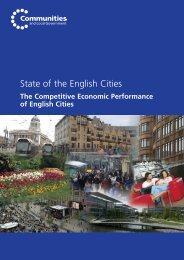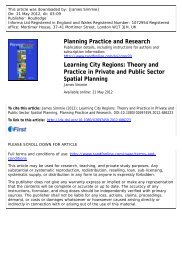History Matters: Path dependence and innovation in British city ...
History Matters: Path dependence and innovation in British city ...
History Matters: Path dependence and innovation in British city ...
You also want an ePaper? Increase the reach of your titles
YUMPU automatically turns print PDFs into web optimized ePapers that Google loves.
5. Strong local social networks. By this<br />
we mean the relative strength of local<br />
social history <strong>and</strong> networks that form an<br />
important part of the norms <strong>and</strong> values<br />
with<strong>in</strong> which local economic activities are<br />
conducted. These can be either a good or<br />
bad th<strong>in</strong>g. Strong local social networks can<br />
encourage conformity <strong>and</strong> consequent path<br />
<strong>dependence</strong>. Successful <strong>in</strong>novative <strong>British</strong>*<br />
cities like Cambridge, Oxford, Warr<strong>in</strong>gton<br />
<strong>and</strong> Read<strong>in</strong>g tend to have high levels of outof-region<br />
<strong>and</strong> <strong>in</strong>ternational social networks<br />
<strong>and</strong> are not limited to their regional<br />
networks.<br />
Knowledge assets drive the ability to<br />
develop new <strong>in</strong>dustrial pathways<br />
The ma<strong>in</strong> differences between lead<strong>in</strong>g<br />
<strong>and</strong> lagg<strong>in</strong>g cities <strong>in</strong> our sample were their<br />
historically developed knowledge assets – such<br />
as universities <strong>and</strong> R&D <strong>in</strong>frastructure <strong>and</strong> the<br />
dynamism of their local <strong><strong>in</strong>novation</strong> systems.<br />
Among the lagg<strong>in</strong>g cities <strong>in</strong> our sample:<br />
• The development of knowledge-<strong>in</strong>tensive<br />
sectors has been slower than elsewhere.<br />
• This has had a knock-on effect on the quality<br />
of human capital with lower proportions<br />
of both knowledge-<strong>in</strong>tensive occupations<br />
<strong>and</strong> those specifically engaged <strong>in</strong> R&D or<br />
university research.<br />
• The comb<strong>in</strong>ation of a few large private sector<br />
employers with a large public sector has not<br />
fostered a culture of enterprise.<br />
• There exists a lack of local <strong>in</strong>vestment<br />
<strong>and</strong> th<strong>in</strong> venture capital markets. The<br />
commercialisation of new ideas also appears<br />
limited by the low proportions of knowledge<strong>in</strong>tensive<br />
bus<strong>in</strong>ess services <strong>in</strong> most of the<br />
least <strong>in</strong>novative <strong>city</strong> economies.<br />
Lead<strong>in</strong>g cities have generally benefited from<br />
the cumulative development of their local<br />
absorptive capa<strong>city</strong> <strong>and</strong> <strong><strong>in</strong>novation</strong> systems:<br />
• They tended to have more people work<strong>in</strong>g <strong>in</strong><br />
knowledge-<strong>in</strong>tensive occupations (KIOs).<br />
• They had more employment <strong>in</strong> R&D <strong>and</strong><br />
university research than other cities.<br />
• This was then reflected <strong>in</strong> higher rates of the<br />
generation of new knowledge <strong>in</strong> the form of<br />
patent applications.<br />
• They were better able to commercialise these<br />
new ideas as a result of higher levels of<br />
knowledge-<strong>in</strong>tensive bus<strong>in</strong>ess services (KIBS)<br />
<strong>in</strong> those cities.<br />
Implications for policy<br />
It is necessary to th<strong>in</strong>k large-scale <strong>and</strong><br />
long-term us<strong>in</strong>g an evolutionary economics<br />
approach to underst<strong>and</strong><strong>in</strong>g change <strong>and</strong><br />
<strong><strong>in</strong>novation</strong><br />
This should be reflected <strong>in</strong> sett<strong>in</strong>g realistic<br />
expectations, <strong>in</strong> policy analysis <strong>and</strong> <strong>in</strong> the<br />
evaluation of specific <strong>in</strong>itiatives.<br />
In lead<strong>in</strong>g areas like Cambridge there was<br />
widespread scepticism among the private<br />
sector firms about the relevance or efficacy<br />
of public policy on <strong><strong>in</strong>novation</strong><br />
Few firms could name any policy that had made<br />
a positive <strong>and</strong> measurable difference to their<br />
<strong><strong>in</strong>novation</strong> activities. Their development was<br />
largely based on the identification of market<br />
opportunities <strong>and</strong> organis<strong>in</strong>g to meet those<br />
dem<strong>and</strong>s. They were more concerned however<br />
with policies related to issues fall<strong>in</strong>g under<br />
Local Authorities jurisdiction, such as plann<strong>in</strong>g.<br />
While public policies targeted specifically at<br />
local <strong><strong>in</strong>novation</strong> had little apparent impact,<br />
several firms noted significant effects<br />
aris<strong>in</strong>g from the consequences of other<br />
k<strong>in</strong>ds of policy<br />
We recorded some criticism of local l<strong>and</strong> use<br />
plann<strong>in</strong>g as be<strong>in</strong>g too slow, bureaucratic <strong>and</strong><br />
unimag<strong>in</strong>ative <strong>in</strong> develop<strong>in</strong>g transport <strong>and</strong><br />
communications <strong>in</strong>frastructure. It was also held<br />
to place too many restrictions on the physical<br />
development of the new knowledge-based<br />
economy.<br />
On the other h<strong>and</strong>, the large-scale town<br />
expansion schemes <strong>in</strong> both Northampton<br />
<strong>and</strong> Warr<strong>in</strong>gton proved to be very successful<br />
at generat<strong>in</strong>g <strong><strong>in</strong>novation</strong> <strong>and</strong> creat<strong>in</strong>g new<br />
<strong>in</strong>dustrial pathways. While the promotion<br />
of <strong><strong>in</strong>novation</strong> <strong>in</strong> itself was not one of their<br />
orig<strong>in</strong>al objectives, much of what they have<br />
achieved has been based on the creation of<br />
an <strong>in</strong>novative set of <strong>in</strong>stitutional <strong>and</strong> cultural<br />
phenomena that positively encourage new<br />
economic growth <strong>and</strong> <strong><strong>in</strong>novation</strong> (even if by<br />
accident).<br />
* The data <strong>in</strong> this report refer ma<strong>in</strong>ly to Great Brita<strong>in</strong>, but references to the United K<strong>in</strong>gdom are made where appropriate.<br />
6













